#sort of (it's brief)
Text
What does life in North Korea look like outside of Pyongyang? 🇰🇵
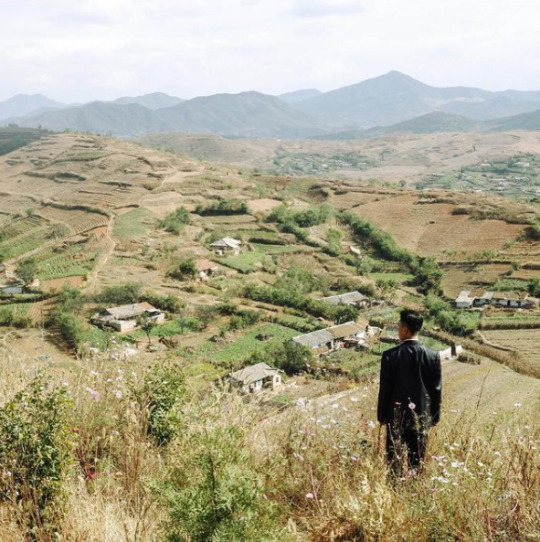
Hey, I'm back again with a very scary "tankie" post that asks you to think of North Koreans as people, and to consider their country not as a cartoonish dystopia, but as a nation that, like any other place on earth, has culture, traditions, and history.
Below is a collection of pictures from various cities and places in North Korea, along with a brief dive into some of the historical events that informs life in the so-called "hermit kingdom."
Warning: very long post
Kaesong, the historic city
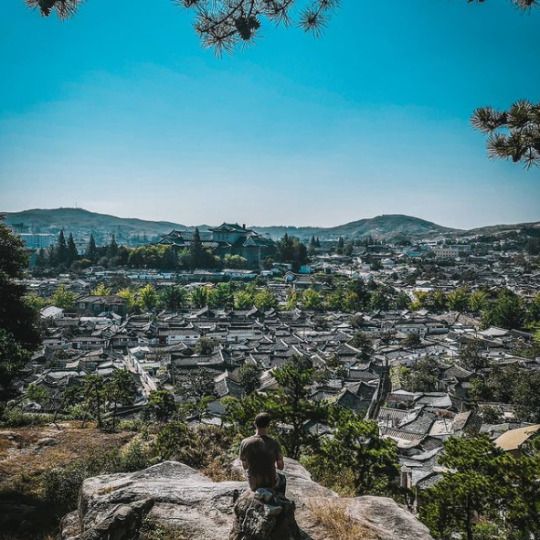
Beginning this post with Kaesong, one of the oldest cities in Korea. It's also one of the few major cities in the DPRK (i.e. "North Korea") that was not completely destroyed during the Korean war.
Every single city you'll see from this point on were victims of intense aerial bombardments from the U.S. and its allies, and had to be either partially or completely rebuilt after the war.
From 1951 to 1953, during what has now become known as the "forgotten war" in the West, the U.S. dropped 635,000 tons of bombs over Korea — most of it in the North, and on civilian population centers. An additional 32,000 tons of napalm was also deployed, engulfing whole cities in fire and inflicting people with horrific burns:
For such a simple thing to make, napalm had horrific human consequences. A bit of liquid fire, a sort of jellied gasoline, napalm clung to human skin on contact and melted off the flesh. Witnesses to napalm's impact described eyelids so burned they could not be shut and flesh that looked like "swollen, raw meat." - PBS
Ever wondered why North Koreans seem to hate the U.S so much? Well...
Keep in mind that only a few years prior to this, the U.S. had, as the first and only country in the world, used the atomic bomb as a weapon of war. Consider, too, the proximity between Japan and Korea — both geographically and as an "Other" in the Western imagination.
As the war dragged on, and it became clear the U.S. and its allies would not "win" in any conventional sense, the fear that the U.S. would resort to nuclear weapons again loomed large, adding another frightening dimension to the war that can probably go a long way in explaining the DPRK's later obsession with acquiring their own nuclear bomb.
But even without the use of nuclear weapons, the indiscriminate attack on civilians, particularly from U.S. saturation bombings, was still horrific:
"The number of Korean dead, injured or missing by war’s end approached three million, ten percent of the overall population. The majority of those killed were in the North, which had half of the population of the South; although the DPRK does not have official figures, possibly twelve to fifteen percent of the population was killed in the war, a figure close to or surpassing the proportion of Soviet citizens killed in World War II" - Charles K. Armstrong
On top of the loss of life, there's also the material damage. By the end of the war, the U.S. Air Force had, by its own estimations, destroyed somewhere around 85% of all buildings in the DPRK, leaving most cities in complete ruin. There are even stories of U.S. bombers dropping their loads into the ocean because they couldn't find any visible targets to bomb.
What you'll see below of Kaesong, then, provides both a rare glimpse of what life in North Korea looked like before the war, and a reminder of what was destroyed.

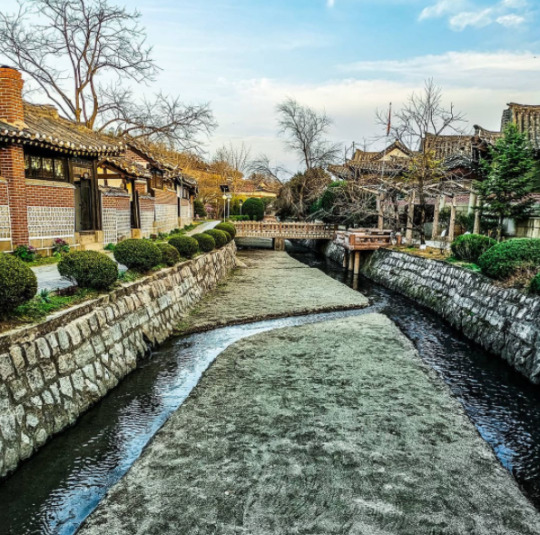

Kaesong's main street, pictured below.
Due the stifling sanctions imposed on the DPRK—which has, in various forms and intensities, been in effect since the 1950s—car ownership is still low throughout the country, with most people getting around either by walking or biking, or by bus or train for longer distances.
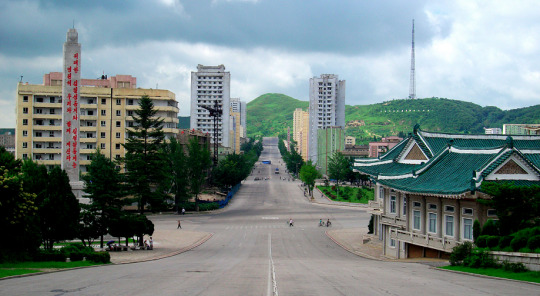
Kaesong, which is regarded as an educational center, is also notable for its many Koryŏ-era monuments. A group of twelve such sites were granted UNESCO world heritage status in 2013.
Included is the Hyonjongnung Royal Tomb, a 14th-century mausoleum located just outside the city of Kaesong.
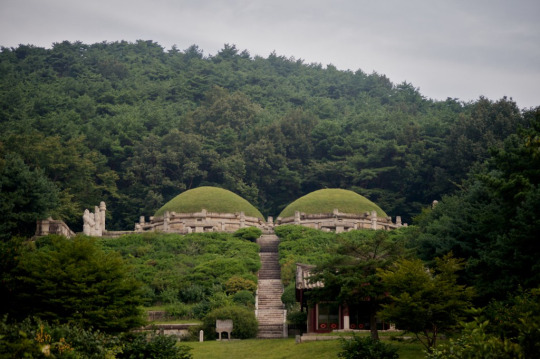
One of the statues guarding the tomb.
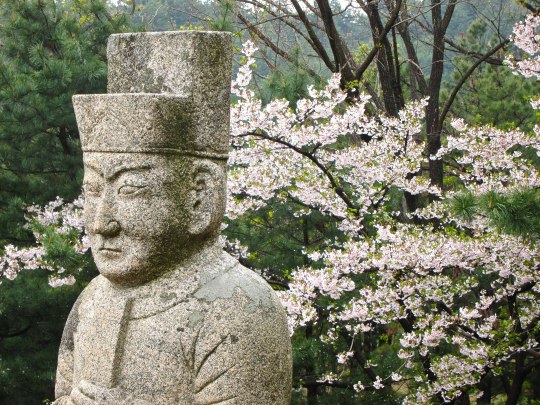
Before moving on the other cities, I also wanted to showcase one more of the DPRK's historical sites: Pohyonsa, a thousand-year-old Buddhist temple complex located in the Myohyang Mountains.

Like many of DPRK's historic sites, the temple complex suffered extensive damage during the Korean war, with the U.S. led bombings destroying over half of its 24 pre-war buildings.
The complex has since been restored and is in use today both as a residence for Buddhist monks, and as a historic site open to visitors.


Hamhung, the second largest city in the DPRK.
A coastal city located in the South Hamgyŏng Province. It has long served as a major industrial hub in the DPRK, and has one of the largest and busiest ports in the country.
Hamhung, like most of the coastal cities in the DPRK, was hit particularly hard during the war. Through relentless aerial bombardments, the US and its allies destroyed somewhere around 80-90% percent of all buildings, roads, and other infrastructure in the city.
Now, more than seventy years later, unexploded bombs, mortars and pieces of live ammunition are still being unearthed by the thousands in the area. As recently as 2016, one of North Korea's bomb squads—there's one in every province, faced with the same cleanup task—retrieved 370 unexploded mortar rounds... from an elementary school playground.
Experts in the DPRK estimate it will probably take over a hundred years to clean up all the unexploded ordnance—and that's just in and around Hamhung.
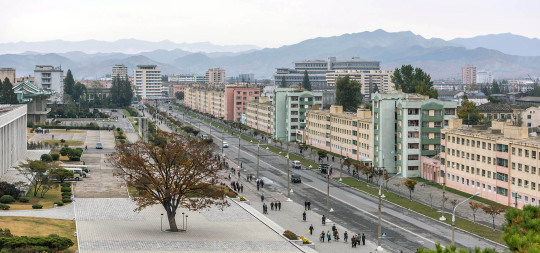

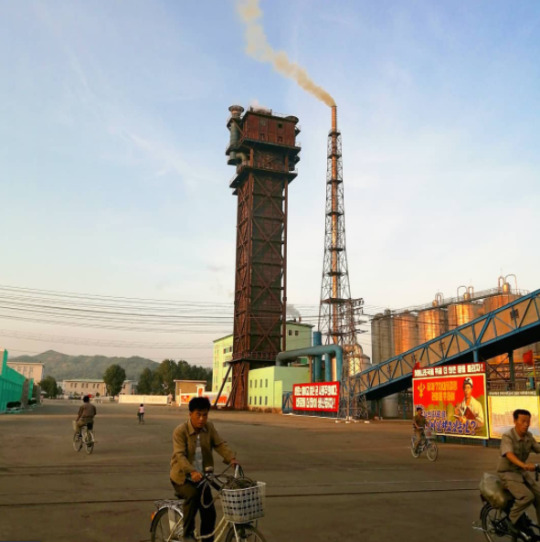
Hamhung's fertilizer plant, the biggest in North Korea.
When the war broke out, Hamhung was home to the largest nitrogen fertilizer plant in Asia. Since its product could be used in the creation of explosives, the existence of the plant is considered to have made Hamhung a target for U.S. aggression (though it's worth repeating that the U.S. carried out saturation bombings of most population centers in the country, irrespective of any so-called 'military value').
The plant was immediately rebuilt after the war, and—beyond its practical use—serves now as a monument of resistance to U.S. imperialism, and as a functional and symbolic site of self-reliance.
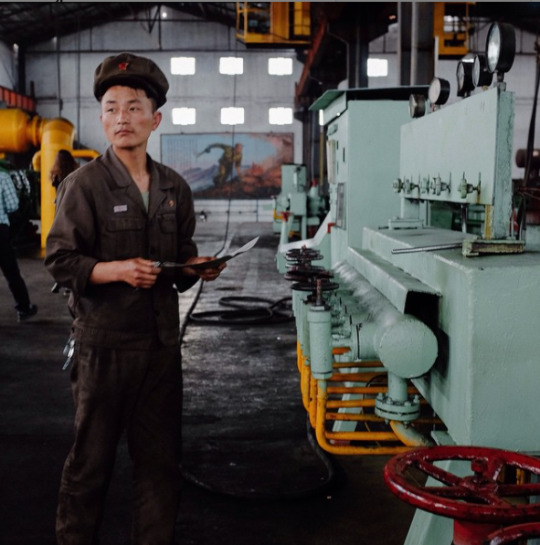
Chongjin, the third largest city in the DPRK.
Another coastal city and industrial hub. It underwent a massive development prior to the Korean war, housing around 300,000 people by the time the war broke out.
By 1953, the U.S. had destroyed most of Chongjin's industry, bombed its harbors, and killed one third of the population.
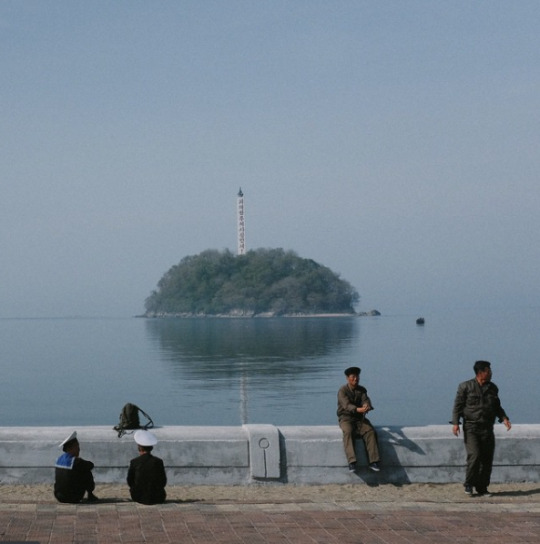
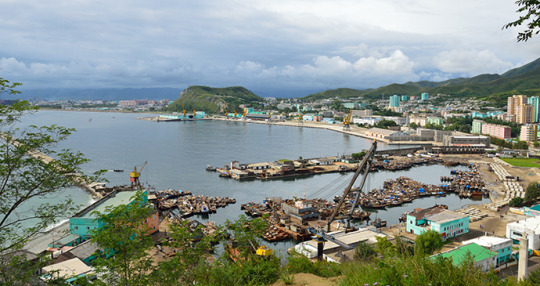

Wonsan, a rebuilt seaside city.
The city of Wonsan is a vital link between the DPRK's east and west coasts, and acts today as both a popular holiday destination for North Koreans, and as a central location for the country's growing tourism industry.
Considered a strategically important location during the war, Wonsan is notable for having endured one of the longest naval blockades in modern history, lasting a total of 861 days.
By the end of the war, the U.S. estimated that they had destroyed around 80% of the city.
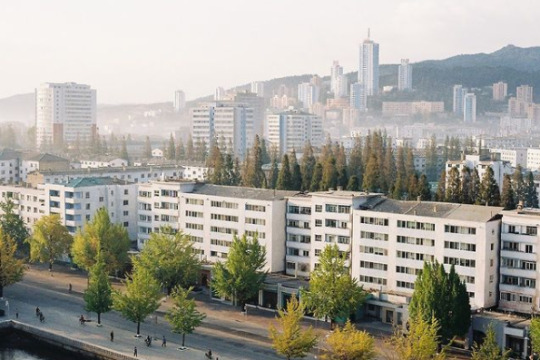

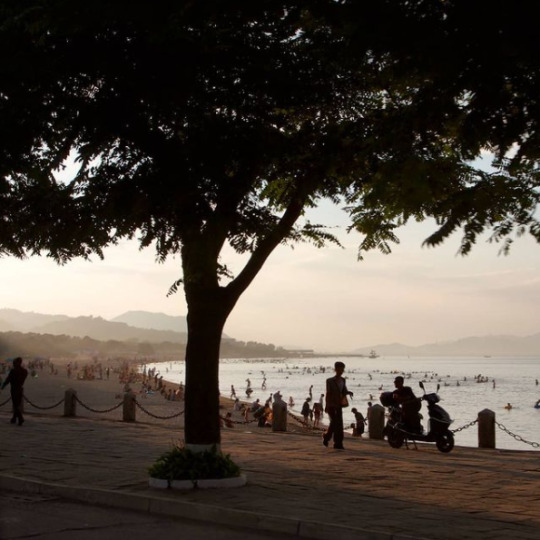

Masikryong Ski Resort, located close to Wonsan. It opened to the public in 2014 and is the first, I believe, that was built with foreign tourists in mind.
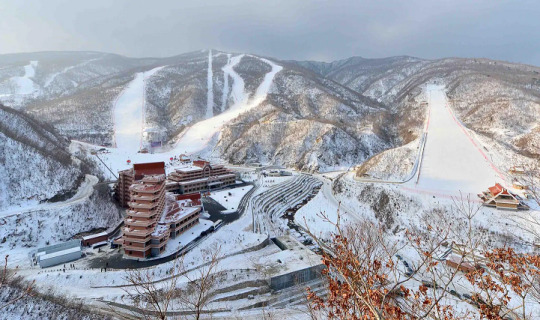
Sariwon, another rebuilt city
One of the worst hit cities during the Korean War, with an estimated destruction level of 95%.
I've written about its Wikipedia page here before, which used to mockingly describe its 'folk customs street'—a project built to preserve old Korean traditions and customs—as an "inaccurate romanticized recreation of an ancient Korean street."
No mention, of course, of the destruction caused by the US-led aerial bombings, or any historical context at all that could possibly even hint at why the preservation of old traditions might be particularly important for the city.
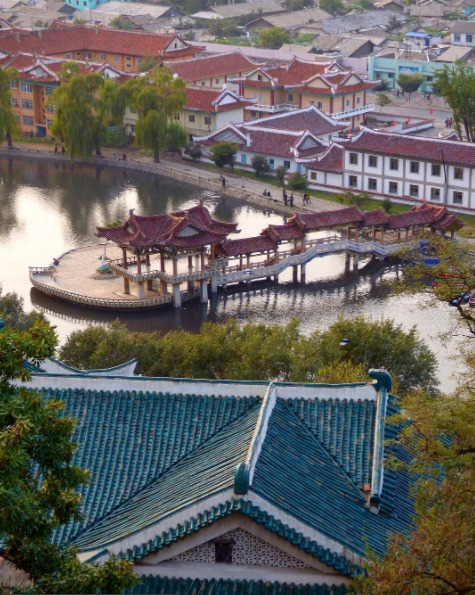

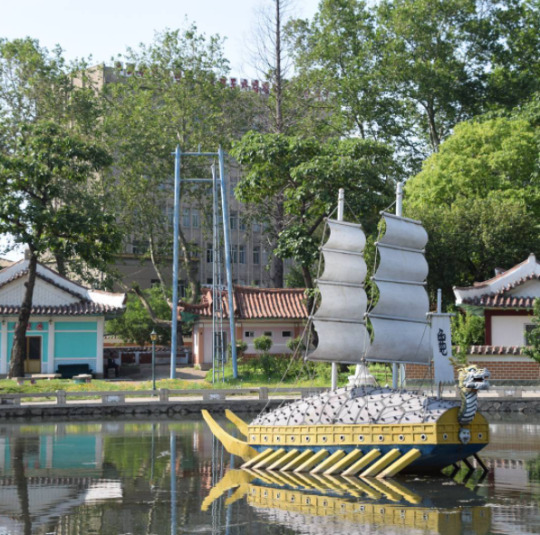
Life outside of the towns and cities
In the rural parts of the DPRK, life primarily revolves around agriculture. As the sanctions they're under make it difficult to acquire fuel, farming in the DPRK relies heavily on manual labour, which again, to avoid food shortages, requires that a large portion of the labour force resides in the countryside.
Unlike what many may think, the reliance on manual labour in farming is a relatively "new" development. Up until the crisis of the 1990s, the DPRK was a highly industrialized nation, with a modernized agricultural system and a high urbanization rate. But, as the access to cheap fuel from the USSR and China disappeared, and the sanctions placed upon them by Western nations heavily restricted their ability to import fuel from other sources, having a fuel-dependent agricultural industry became a recipe for disaster, and required an immediate and brutal restructuring.
For a more detailed breakdown of what lead to the crisis in the 90s, and how it reshaped the DPRKs approach to agriculture, check out this article by Zhun Xu.

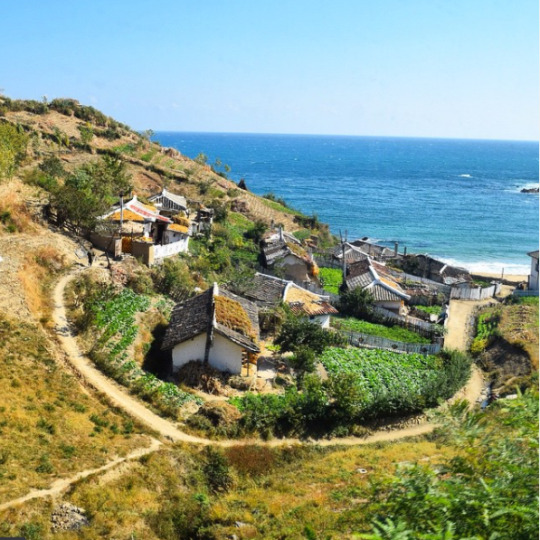
Some typical newly built rural housing, surrounded by farmland.
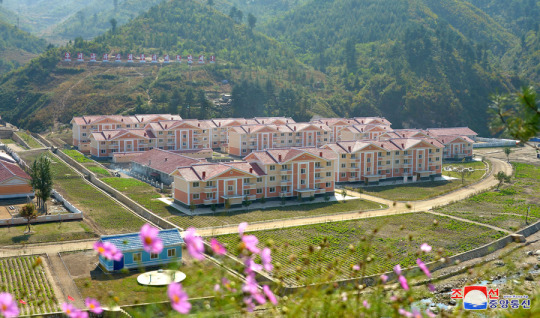
Tumblr only allows 20 pictures per post, but if you want to see more pictures of life outside Pyongyang, check out this imgur album.
#dprk#north korea#i've had this post unfinished in drafts for almost a year#also sorry about the spelling and potential formatting issues it's a nightmare to edit at this point#it was literally just meant to be a collection of picture and then the writing just sort of happened#enjoy the brief heritageposts history lesson i guess
6K notes
·
View notes
Text

birb bookmarks!!!
#gonna be opening up a shop reaaal soon aaaAAH#so here's a little sneak peak of something#some sort of brief respite from all the zelda I wanna dump everywhere all at once#art#elgatoiberico
530 notes
·
View notes
Text
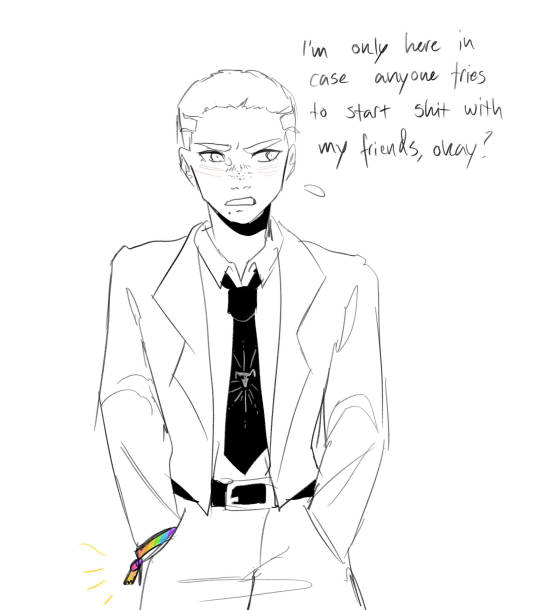
Tiny doodle before I gotta run off. Mob boss watching the pride parade
#Fuyuhiko kuzuryu#Sdr2#Super danganronpa 2#An art#Its pride month in Europe now and I love this time#Made brief friends with a bunch of americans yesterday they're always so fun lol#The varying degrees that people show support or their love.... me in my gayass rainbow wing outfit. Older lady with pastel rainbow streaks#Fuyuhiko cant afford to come out with his....situation... but the excuse of protecting his friends at least let's him watch from a distance#Pretend like he can have the sort of life that lets him be more authentic to himself#Before he gets older and is expected to eventually marry or at least have kids (if he lives that long)#Anyway.
1K notes
·
View notes
Text

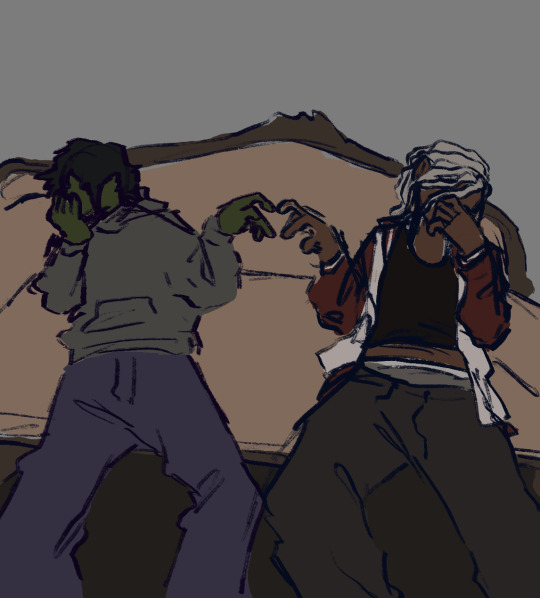



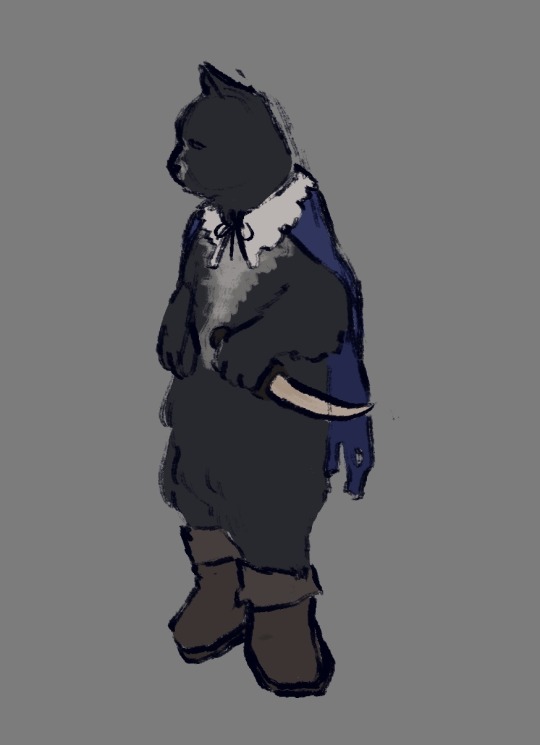

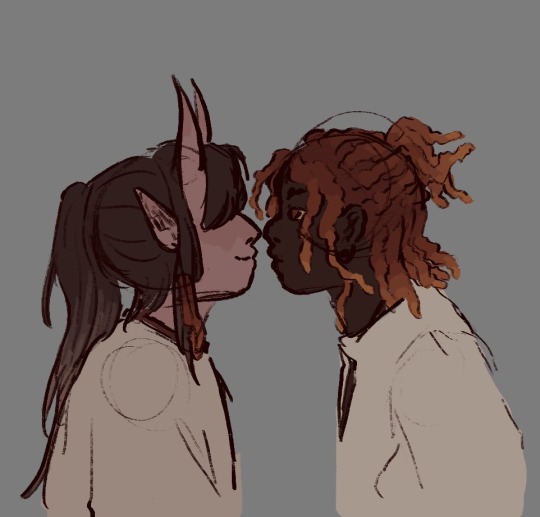
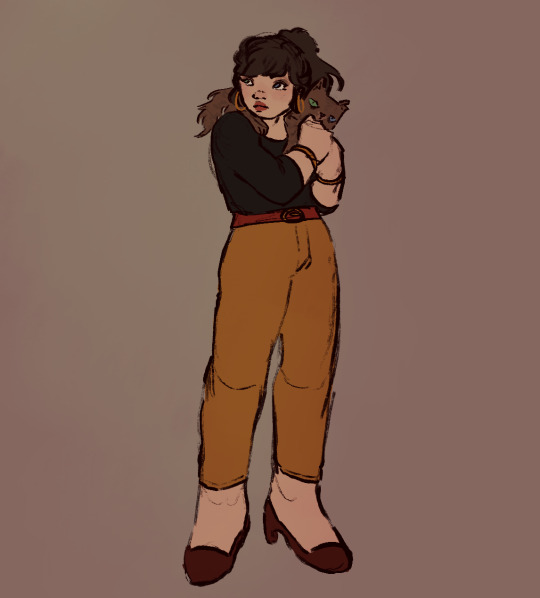
[start i.d.: nine colored sketch drawings of various dimension 20 characters. the first is fig playing her bass, her hair shaggy in her eyes. the second is gorgug and fabian slouched on a couch, looking away from each other but forming a hand heart together. the next four are individuals of baron, markus st. vincent, adaine, and pib. the seventh is kristen and tracker spooning. the eighth is fig and ayda standing so close their noses touch. the last is of sofia with la gran gata around her shoulders. end i.d.]
a bunch of doodle requests from twitter. hi
#ur invited to make reqs here just no promises i’ll get to them#sorry for the very brief id but it is honestly equivalent to the visual quality of these so eh#fantasy high#dimension 20#fhsy#ok now to tag characters HHH#fig faeth#gorgug thistlespring#fabian seacaster#baron from the baronies#markus st vincent#adaine abernant#pib neverafter#kristen applebees#tracker o'shaughnessey#ayda aguefort#sofia lee#my art#digital art#simply for. sorting purposes
1K notes
·
View notes
Text

erdtree burial watchdog
#elden ring#fr misc resources#fr resources#don't follow me for elden ring content it's going to be like shopping for clothes in the soup store#anyway i had an incredibly brief phase of watching this guy who pits soulsborne bosses against each other and all sorts of wild things
240 notes
·
View notes
Text
the ‘gross plug that makes you pay for weed with sex’ trope is hot but why are we not considering the opposite. what if i was ur nerdy soft plug who smokes you up but you’re a pervert and you keep trying to get me to fuck you for a discount? what if you keep saying “oh… im a twenty short..” and you give me those eyes and try to get me to come onto you but i just say “oh that’s alright, you can pay the rest next time :)” and it makes you so pent up you snap? what then?
#!!#i had a very brief stint as a plug and it was honestly kinda fun to sort everything out and label it. hi autism diagnosis.#counting this as intox#intox#weed intox#t4t intox#intox fantasy#💭
106 notes
·
View notes
Text
LSTR-S2301 and the maintenance tunnel ARAR are best friends to me even though that Elster was only on sierpinski for a seemingly brief time, they’re bros who fuck around on the clock during work. I think Elster was probably more willing to put extra time in however she’s also very “okay you’ve given me a list of tasks I did them. They’re done and done well. That’s it, my time now.” Whereas I see Ara being more of a slacker (very valid of her) or at the very least just a bare minimum type of gal when it comes to work.
Idk I tend to imagine them fucking off in the middle of shifts to go find weird lonely corners of sierpinski to hang out in. They don’t even talk half the time but they love it.
#listen I know sierpinski Elster has Alina as her lover#I don’t necessarily see Elster/ara as romantic although it could be#they’re just tired work bros to me#u have machine autism and plant autism and they’re both silent types I think they’d click#I’ve seen some fun takes on Lilith and Elster as characters too#to me Lilith Itou is definitely the strong silent type but not bc she always means to be#yes she is an intimidating war veteran but I think part of that intimidation factor comes from her being awkward as hell when it comes#to talking#combo of awkward/ just being a woman of few words anyway#which comes through in LSTRs I think#they don’t say much when they don’t feel that they need to ig#anyway idk if this makes sense I’m just rambling#I was also just trying to think abt LSTR-S2301 bc poor thing#imagine being your own individual replika but you’re brought to this place as basically a sacrificial lamb? of sorts#in that you as you are. it’s not what you need to be for a god’s purpose#but it’s close enough that the parts that aren’t needed can be stripped away#and filled again#she was only ever meant to be a vessel for 512 in many ways#but she was still S2301 and had her own life and friends for a brief moment in time#signalis#this isn’t worded well but gets the tag regardless#I should make a rambles tag separate from my personal tag maybe#lynx rambles#<- new tag ig
59 notes
·
View notes
Text

Quick sketch after @serenityhime1 picked “draw something that makes you happy” in my ask game. I don’t usually draw Vegebul in a realistic way but I had fun doing this. It might be the beginning of a new drawing phase 🤔
#vegebul#vegeta x bulma#Vegeta#bulma briefs#vegebul fanart#dbz#otp#why do I keep picking poses and references that have the most ridiculous hand gestures#I hate drawing hands but I keep accidentally challenging myself#I was inspired by a moment in endeavor for this one#but I feel like this lends itself to any sort of#pillow talk vegebul moment#haven’t decided if I’m gonna shade and color it in or not
69 notes
·
View notes
Text







Geets gets it.
#how can u commit atrocities if u don't feel cute??#dbtag#i'm a little sad that geets vanity was sort of overshadowed after namek because him being a little fashionista has and always will be#one of my favorite character choices the series ever made for him#every time i hear that 'i love when a beautiful woman has a gay little boyfriend' tiktok audio i'm like 'that's them your honor'#I feel like it shows in his fashion choices in Super though. Fitted tops + comfy bottoms + boots. He's up to date on Earth's fashion now#No more borrowing clothes from Dr Brief (iirc this is anime-only but it's good and I'm keeping it because Dr Brief is an absolute madman)#I absolutely headcanon that he kept the Badman shirt though that's his now#That's the shirt he was wearing when he met his son for the first time it's probably framed in Bulma's office
84 notes
·
View notes
Text
With regards to the Doctor constantly being described as tall in the EDAs I was interested and briefly heartened to find this exchange when skipping back through Seeing I:
‘I dunno,’ said Orin, ‘I kinda figured he’d be… well, taller.’
‘He acts tall,’ murmured Sam. She thought of the spindly figure who’d unfolded himself upon entering the TARDIS, who’d stumbled off down a dark corridor looking as if he wanted to curl up into a ball. ‘Usually.’
Unfortunately the feeling was only brief and we’re back to normal with the same authors in Unnatural History:
‘Who the hell are you?’ asked Sam Jones.
A tall, slender man wearing fancy dress stared back at her through the chain on her door.
*head desks*
#brief but glorious#kate orman was a member of the pmeb if i remember rightly#you’d think she might have been aware of paul’s height#or rather lack of it#edas#paul mcgann#i can sort of see sam maybe thinking of him as tall#given she isn’t if i recall correctly#i mean i’m 5’3” so to me 5’8” is tall#but later in UH they mention being able to pick him out in a crowd because his hair is easily visible above other heads#and that would definitely not happen
79 notes
·
View notes
Text
i love how unfatherly crowley and aziraphale both are when it comes down to it. sure aziraphale is more than willing to give the young people in his life help and advice and be their friend but he and crowley spent six years (eleven in the book) practically raising a kid (you just know his parents weren't around that often) and by the end they didn't even like him. crowley even suggested they just fucking kill him. he turned three kids into lizards for annoying him right after he destroyed their house. like it was that or kill them obviously but he did NOT hesitate with the newts. that's so funny to me. they're just inherently disinclined to parenthood. we need more characters like them actually
#good omens#i think if aziraphale HAD to take care of a baby no choice he would give them some cocoa#and play mozart for them and just kind of let them do their thing in the bookshop. away from the books of course.#like he would make sure they were safe and sheltered and he would be kind to them#but it would really show that he was just imitating fathers he had seen in books#crowley was not meant to raise children. he's a wine aunt plain and simple. he'd love to be called 'auntie crowley'#but he has no friends with kids so he has to be content with his brief stint as nanny.#the demon put a basket with a baby in it in the backseat of his car untethered and let it slide around#from side to side while he drove dangerously. canonically that is something he did#it's also my headcanon that he has some complicated feelings about parenthood and family roles#yknow. when you're technically one of 'god's children' but she cast you and so many of your siblings down to hell for asking questions#when the closest thing you have to a mother made you murder innocent children for a bet.#it can make you hesitant about that sort of thing!
173 notes
·
View notes
Note
r.e. that last ask, did machete whimper when he died? was he permitted one last moment of softness? or did he snarl, forever known to the world as hard and cold?
The first stab had collapsed his left lung so I think he most likely tried to cough and wheeze feebly because he was struggling to get enough air.
#maybe some kind of choking rattle right at the end since it's the puncture wound to the neck that killed him#answered#featherfrond#Vaschete lore#getting sort of morbid here but since you asked#death#cw death#he didn't die with great poise and poetic tragedy#he was caught by surprise alone so I think he most likely only had the time to feel brief shock disbelief and panic
201 notes
·
View notes
Text
"Administratively, too, [...] queens were considered the legal lords of their landholdings. [...] Grants noted that the queen's officials had administrative autonomy without being subject to the king or anyone else, and evidence of the same assumption can be gleaned from court rolls that were recorded with headings indicating the lord of the manor whose court proceedings were being enrolled. As an example, some court rolls for the manor of Haveringatte-Bower specified that it was the court of [Margaret of Anjou] that was in session, while later rolls recorded Elizabeth Woodville as the lord of the manor court."
-Michele Seah, 'My Lady Queen, the Lord of the Manor': The Economic Roles of Late Medieval Queens", Parergon, Volume 37, Number 2, 2020.
#queenship tag#margaret of anjou#elizabeth woodville#I really appreciated how Seah acknowledged the uneven surviving evidence for her subjects and how that affects her analysis.#It was very brief but it was more than what most historians do so it was very refreshing :)#my post#english history#this is for @ anon who asked if its true that Margaret mostly hosted her own courts while EW mostly stayed with her husband#I'm not sure which (if any) historian has said something like this* but I highly doubt it's true !#We don't really have solid itineraries in place for either queen to make any kind of firm conclusions of the sort#(ie: about their residences or anything else) though I'm sure it would have varied depending on the situation#But either way it's explicitly clear that both Margaret and Elizabeth held their own courts in their own lands on multiple occasions#And we also have evidence of both of them residing with their husbands in regular circumstances#*tbh this is too long to get into right now but this assumption does fit into the few 'revisionist' interpretations of both Margaret and EW#(which imo is just as degrading as her traditional interpretation for the latter) so I wouldn't be surprised if some#historians may have framed their situations in such a way and relied entirely on their own assumptions to do so#Either way as far as I know there is no evidence of any such contrast existing - at least not on a consistent basis.#and the evidence we do have contradicts the assumption#Hope this helps! I figured a proper excerpt from this article would clarify the point better than any direct answer from me <3#also in case anyone was wondering I *think* the title ('My Lady Queen the Lord of the Manor') was referring to administrative accounts#of EW based on what Seah wrote here - though ofc I'm not sure#queue
47 notes
·
View notes
Text

TRUNKS DRAGONNNNNNNN
#wishy speaks#my art#trunskepon#sort of#dbz#dragon ball z#trunks#trunks briefs#future trunks#i am in a dragon mood since i finished spyro 1
22 notes
·
View notes
Text
Before the leaks tonight, my main notes in the department of “Izuocha not gonna be canon next chapter” is that tsu and Izuku were repeatedly chosen and placed to be in the same, worrying attitude for Ochako’s distance/absence.



Tsu was such a good subtle detail for this chapter as well. That gay ass signaling on Izuocha was so good. Like “this is platonic! Her and Izuku worry over Ochako equally!” And damn Horikoshi you really highlighted, underlined, and bolded in big bright letters Lavender Marriage for these two lmao
My other main detail is the way that Ochako’s/Izuku’s feelings are presented.

Specifically with this last little caption (that isn’t there in the officials for some reason???) on the very last page—

Pika’s translation btw
Maybe y’all don’t get it bc you need it put into perspective: the very idea that there would be a “no ships ending” is… absolutely insane. The fact that it’s the main opinion as well is even crazier.
And to put it into perspective even more, the reason it’s a common belief has to come from the idea that Ochako’s feelings are simply unrequited. A “no ships ending” wouldn’t make sense without it. Do the people saying that realize that it’s what they’re saying? “No time” isn’t a good justification, he had the time, he just used it on… other characters instead. If you believe this, you’re making the argument that Ochako’s story is about unrequited love
This line “The girl’s hidden feeings, and as for deku—..”
I fully understand what the feelings are talking about (Himiko’s death, the respective villains even if they aren’t equatable, etc), but it’s the implications of the way it’s written. It’s presenting it as Ochako’s feelings… for Izuku. It then asks the question, “..DOES Izuku feel the same way?” Because I mean, does he?
Now, I don’t think we’re getting any sort of confession. I could say in detail as to why, but that would be more like repeating the same 5 posts on my feed all week.
Because ultimately, it won’t happen. It’s another bait and switch, like it always is. And Horikoshi knows this.
So that’s why it’s so amazing that this line is here, it’s teasing, almost. Like “Look! The straight relationship is on the horizon! Just follow the cookie! It’s totally where you think it leads..”, and then signaling the warning bells in your head that not everything is as it seems.
Why make Ochako break down crying? Why not confirm Himiko’s death? Why make all of this romantic heartache? Why make straight shippers hold their breath, and then lead them into this supposed security?
Why ask a question on feelings, if it’s supposed to be a given?
#I promised myself I would post any sort of brief evidence on this before the leaks came out#but not when I’d actually written this#bc I’m ngl I wrote this like. almost a week ago. a day or two after the leaks came out.#I just felt like waiting since a lot of certain people decided to get weird and misogynistic all of a sudden. so here’s your slop.#this is a re-written brief version where I don’t go on three tangents on Izuku and Ochako’s characters#bkdk#togachako#I mean it when I said I waited to post this. luckily for me I didn’t see anyone else particularly point out these details before I did but-#GOD I haven’t been so angry at every part of this fandom in a while#trad wife misogyny to getting in the way of my gay ship misogyny I was so tired#and I better not see an even bigger spike in the 10% chance that Izuocha is canon. you can be sad without dismissing ochako#or I stg I’m becoming an Izuocha shipper full time people cannot be acting like this in the year of 2024#my Izuocha shipper threat is 1000% real and it’s only in the case that bitches don’t behave
39 notes
·
View notes
Text
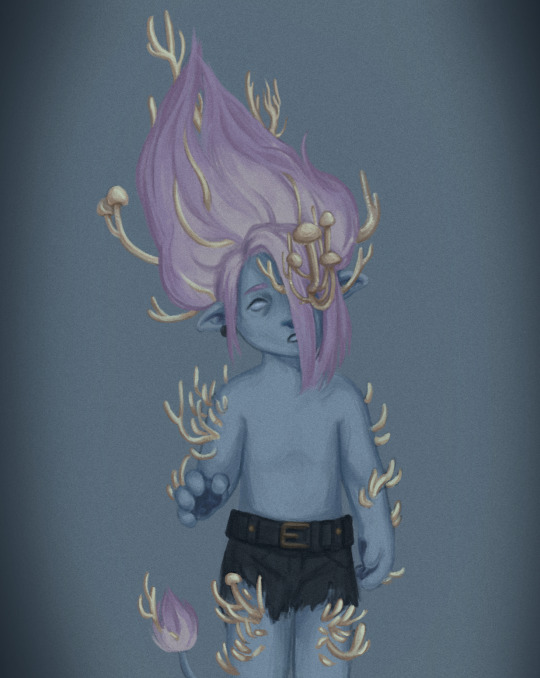
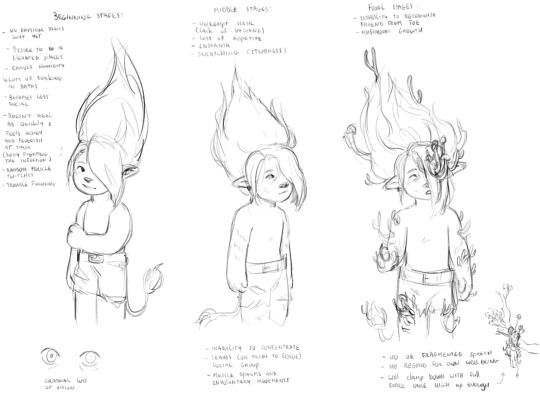
little horror concept based on cordyceps :3c
with thanks to @cozyqueerchaos for helping me brainstorm!
#a brief interlude before i get back to finishing the requests! i wanted to refamiliarize myself with rendering in procreate#since my pc is still a little too fried for me to feel comfy drawing on it :'))#anyway this is based on an AU. like an AU of an AU? where floyd does get revived post band-together but comes back wrong#because im a horror artist at heart - believe it or not LMAO#trolls#dreamworks trolls#trolls band together#trolls floyd#floyd trolls#art#my art#body horror#cordyceps#idk if i'll end up doing more trolls horror art. im not the biggest fan of using kid's media for horror stuff (save for analog horror maybe#at least in visual art#this just sort of happened LMAO#fanart
51 notes
·
View notes